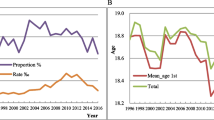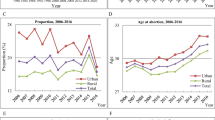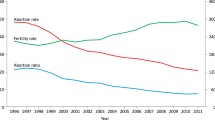Abstract
Objectives
The purpose of this study was to examine trends in induced abortions in Japan.
Methods
The Ministry of Health, Labour, and Welfare compiled data on induced abortions, live births, and the population of women aged 15–49 years. These data were provided by 47 prefectures in Japan and were used to examine the number of induced abortions and various characteristics of women who received abortions from 1955 through 2001. We examined abortion numbers, abortion ratios (number of legal abortions per 1,000 live births), and abortion rates (number of legal abortions per 1,000 women aged 15–49). We were particularly interested in examining abortion trends among adolescents. These trends were also compared to those in the United States.
Results
A total of 341,588 legal induced abortions were reported in Japan in 2001, representing a 2.5% increase from 1998 to 2001. From 1998 to 2001, the abortion ratio (292) increased by 5.4%; from 1996 through 2001, the abortion rate (11.8) increased by 8.3%. Women less than 20 years old contributed most to these increases. In 1999, the abortion ratio among Japanese adolescents was 5.7 times as high as the ratio among U.S. adolescents, while the abortion rate among U.S. adolescents was 1.8 times as high as the rate among Japanese adolescents.
Conclusions
Recent increases in induced abortion among Japanese women may be related to several factors, including changes in sexual behavior among adolescents and a decline in their use of contraceptives. More appropriate educational efforts and interventions are needed to prevent unintended pregnancies.
Similar content being viewed by others
References
Wagatsuma T. Reproductive Health. Tokyo: Nankodo Co., Ltd., 2002. (in Japanese)
Ministry of Health and Welfare, Minister’s Secretariat. Statistics Information Bereau, Maternal body protection statistics reports. Tokyo: Health and Welfare Statistics Association, 2002. (in Japanese)
Health and Welfare Statistics Association. Vital Statistics. Tokyo: Health and Welfare Statistics Association, 2002 (in Japanese)
Centers for Disease Control and Prevention. Surveillance Summaries, November 29, 2002. MMWR. 2002; 51: 1–28.
Centers for Disease Control and Prevention. Surveillance Summaries. April 13, 2002. MMWR. 2002; 51: 1–32.
Centers for Disease Control and Prevention. Surveillance Summaries, December 8, 2000. MMWR. 2000; 49: 1–44.
Centers for Disease Control and Prevention. Surveillance Summaries, July 30, 1999. MMWR. 1999; 48: 1–44
Centers for Disease Control and Prevention. Surveillance Summaries, July 3, 1998. MMWR. 1998; 47: 31–68.
Centers for Disease Control and Prevention. Surveillance Summaries, August 8, 1997. MMWR. 1997: 46: 37–98.
Centers for Disease Control and Prevention. Surveillance Summaries, May 3, 1996. MMWR. 1996: 45: 1–36.
Centers for Disease Control and Prevention. Surveillance Summaries, May 5, 1995. MMWR. 1995: 44: 23–53.
Centers for Disease Control and Prevention. Surveillance Summaries, December, 1993. MMWR. 1993; 42: 29–57.
Goto A, Koriyama CF, Fukao A, Reich MR. Abortion trends in Japan, 1975–95. Stud Fam Plann. 2000; 31: 301–308.
Population Problem Research Council. Summary of 25th National Survey on Family Planning: Mainichi Newspaper Publishing Company: Tokyo, 2000. (in Japanese)
Vital and Health Statistics. Fertility, Family Planning, and Women’s Health, New Data from the 1995 National Survey of Family Growth, 2002: 23(19).
Martin JA, Hamilton BE, Ventura SJ, Menacker F, Park MM, Sutton PD. Final data for 2001. National vital statistics reports. 51(2). Hyattsville, Maryland: National Center for Health Statistics, 2002.
Tokyo To You chuu kou sinsyousei kyouiku kenkyuukai. Jidou seito no sei. Tokyo Gakkou Tosho, 2002, (in Japanese)
NHK Hoso Bunka Kenkyujo. The Mind of the Modern Japanese. Tokyo: Broadcasting Publish Company, 1998. (in Japanese)
Maruyama H, Raphael JH, Djerassi C. Why Japan ought to legalize the pill. Nature. 1996; 379: 579–580.
Singh S, Darroch JE. Adolescent pregnancy and childbearing; levels and trends in developed countries. Fam Plan Perspect. 2000; 32: 14–23.
Cushman LF, Romero D, Kalmuss D, Davidson AR, Heartwell S, Rulim M. Condom use among women choosing long-term hormonal contraception. Fam Plann Perspect. 1998; 30: 240–243.
Kihara M, et al. HIV/AIDS Sueveillance in Japan, 1984–2000. J Acquir Immune Defic Syndr. 2003; 32: S55-S62.
Kumamoto Y. Kono Seikansensyou ryuukou no genjou wo tyokushi shitehoshii. Jpn J Sex Transm Dis. 2002; 13: 14–20. (in Japanese)
Kihara OM, Kramer JS, Bain D, Kihara M, Mandel J. Knowledge of and attitudes toward the pill: result of a national survey in Japan. Fam Plann Perspect. 2001; 33: 123–127.
Numazaki I. Haramaseru sei no jikosekinin. Impaction. 1997; 105: 86–96. (in Japanese)
Kihara M, et al. Socio-Epidemiological Studies on Monitoring and Prevention of HIV/AIDS, Kyoto, 2001. (in Japanese)
Hacker NF, Moore JG. Essentials of Obstetrics and Gynecology. Philadelphia: W. B. Saunders Company, 1998.
Rosenberg MJ, Waugh MS. Latex condom breakage and slippage in a controlled clinical trial. Contraception. 1997; 56: 17–21.
Goto A, Yasumura S, Reich MR, Fukao A. Factors associated with unintended pregnancy in Yamagata, Japan. Soc Sci Med. 2002; 54: 1065–1079.
Mauldon J, Luker K. The effect of contraceptive education on method use at first intercourse. Fam Plann Perspect. 1996; 28: 19–24.
NHK “Project of Sexuality of Japanese”. Data book NHK Nihonjin no seikoudou seiishiki. Broadcasting Publish Company, 2002, (in Japanese)
Henshaw SK. Induced abortion: a worldwide perspective. Fam Plann Perspect. 1986; 18: 250–254.
Matsuyama E. Kakukuni ni okeru jinkoutyuuzetu no jittai. Sanfujinka no jissai. 1988; 37: 1249–1256.
Coleman S. Family Planning in Japanese Society: Birth Control in a Modern Urban Culture. Princeton University Press, 1991.
Author information
Authors and Affiliations
Corresponding author
Rights and permissions
About this article
Cite this article
Baba, S., Tsujita, S. & Morimoto, K. The analysis of trends in induced abortion in Japan—An increasing consequence among adolescents. Environ Health Prev Med 10, 9–15 (2005). https://doi.org/10.1265/ehpm.10.9
Received:
Accepted:
Issue Date:
DOI: https://doi.org/10.1265/ehpm.10.9




